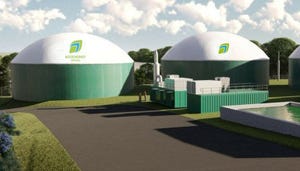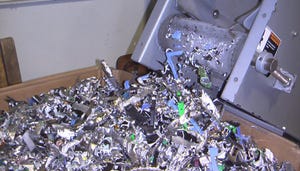TECHNOLOGY: Electrical Energy Cleans Up Soil Contamination
May 1, 1995
William D. Siuru
Scientists at the Pacific North-west Laboratory (PNL), Richland, Wash., are developing an innovative technique that uses electrical energy to remove and destroy toxic, organic soil contaminants. The six-phase soil-heating process is part of PNL's program, Electrical Reme-diation at Contaminated Environ-ments (ERACE), aimed at removing volatile and semi-volatile chemicals from soils.
The technique (see diagram) splits conventional electric power, which is in three phases, into six electrical phases. The phases are delivered to six electrodes in a circle in the soil. Because of the phase differences, each electrode conducts with the other five electrodes resulting in resistive heating of the contaminated soil. This increases the vapor pressure of the volatile and semi-volatile contaminates and enhances their removal rate. Elec-trical soil heating also can create an in-situ or localized source of steam to strip contaminants from the soil.
This "steam cleaning" process ac-tually boils the moisture in the soil. Another electrically-neutral pipe in the circle's center is connected to a vacuum blower which is used to vent the vaporized contaminants and transport them to a storage tank.
At the Department of Energy's Savannah River Site in South Carolina, a prototype six-phase soil-heating setup was used to de-contaminate a 10-foot clay region that was 40 feet in diameter and 40 feet below the surface. The region was contaminated with trichloro-ethylene and perchloroethylene. Soil samples reportedly showed that the technique removed 99.9 percent of the contaminants after 25 days. In contrast, conventional soil vapor extraction techniques could have taken several years.
The six-phase soil-heating technique can be used to remediate toxic wastes such as dry cleaning fluids, carbon tetrachloride, gasoline and jet fuels, according to re-searchers.
PNL researchers also have found that electrical soil heating has certain advantages over other soil heating methods. For instance, steam or hot injection normally requires permeable, unsaturated soils. In contrast, electrical heating, which raises the soil temperature internally, can be used in soils such as clays and silts with low permeability and high water content and in locations where the contaminants are held in impermeable layers.
Compared to other resistive heating techniques, the Six-Phase Soil-Heating process reportedly can de-liver significantly more electrical power to the soil and therefore re-quires fewer electrodes. It also re-sults in more uniform heating and uses conventional three-phase electrical power obtained from the normal utility power grid. In contrast, other electrical heating techniques such as radio frequency or microwave heating require specialized, higher-frequency power sources which require five to 10 times greater capital investments.
PNL is a research facility operated by Battelle Memorial Institute for the U.S. Department of Energy.
You May Also Like


